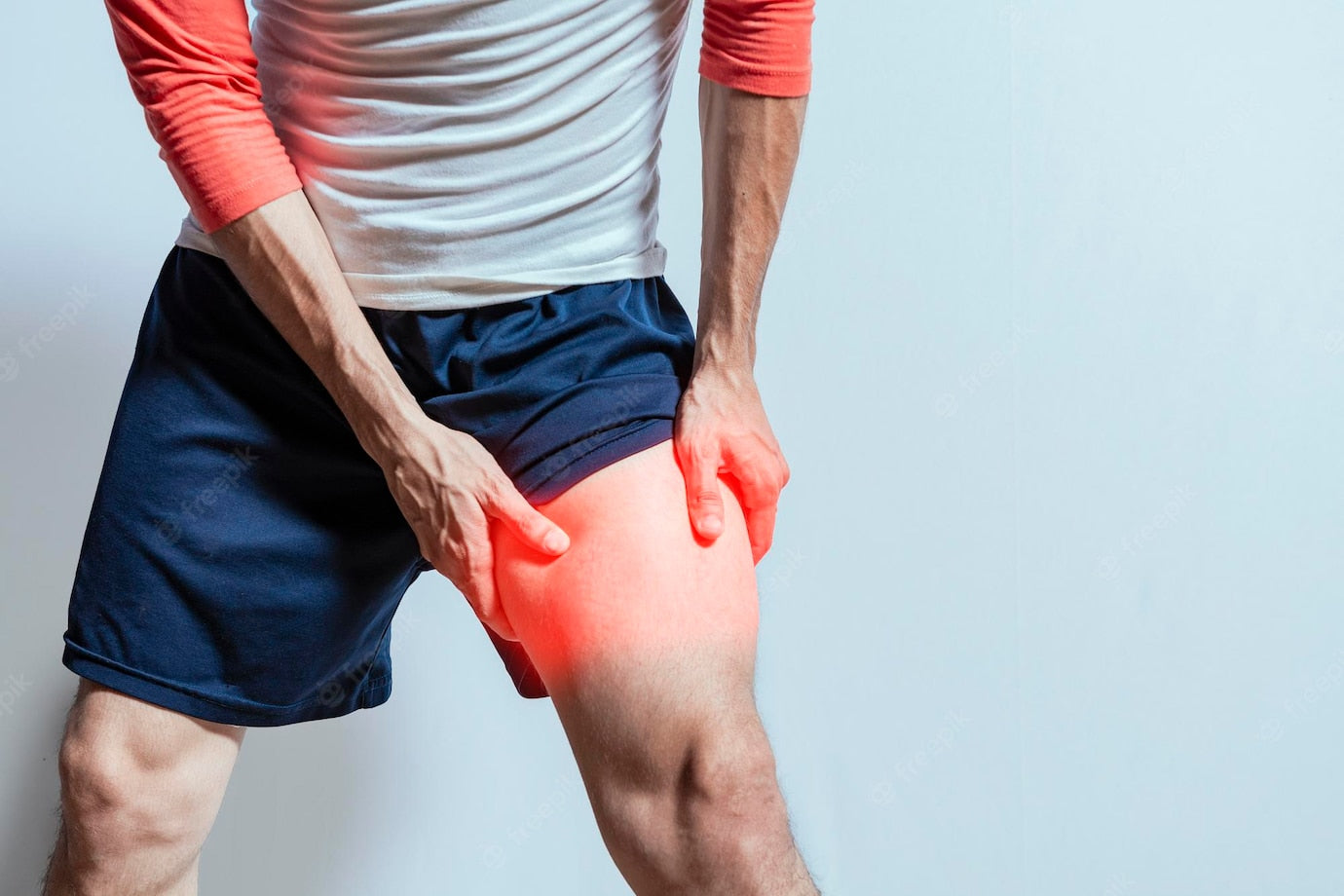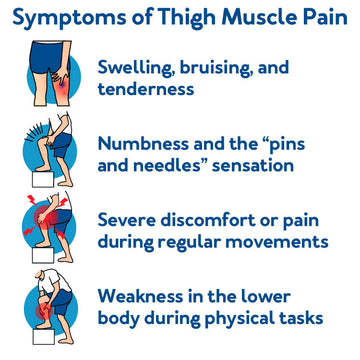
Why Is Your Thigh In Pain?
Experiencing thigh pain?
This article covers the basics of the thigh, its locations, and the symptoms and causes
of thigh pain.
START READING
Related ARticles
- Why is Your Thigh in Pain
- How to Cure Thigh Muscle Pain
- The Ultimate Guide to Thigh Stretches
- How to Relieve Thigh Pain at Night
- How to Deal with Thigh Pain When Sitting
How to Understand & Manage Your Thigh Pain
Thigh pain affects almost 10% of the adult population, increasing with age. Because of how vital the thigh is for sitting, lifting, and walking, thigh pain can be painful and debilitating.
This article seeks to understand the symptoms & causes and highlights measures to correct them. Comprehending the reasons behind your thigh pain can ensure you manage a life free from pain and mobility challenges.

Understanding Thigh Pain
Your thighs exist for several reasons.
First, they exist to move the lower parts of the body through rotating, flexing, and bending. Thigh muscles keep the lower limbs aligned, provide balance, and support the body’s weight. Due to these crucial functions, many of which are intense and repetitive, thighs are prone to injuries.
The causes of thigh pain can be several reasons, including muscle, bone, nerve, and blood vessel issues. Fractures and weak bones can cause thigh pain. Muscles from overuse, degenerative conditions, or advanced age can lead to significant thigh pain.
As the thighs are central to movement and posture, any condition that affects them can have painful effects.
Location of Thigh Pain
Pinpointing the exact area of thigh pain can help identify issues that the thigh may face and can help understand the causes of thigh pain. Understanding the cause of the thigh pain is critical to finding a solution that is both fast and holistic. These are some of the most common thigh pain locations and what they mean:

- Front Thigh Pain: Known medically as the anterior, the pain in the front part of the thigh is associated with excessive usage or physical trauma. Addressing the pain promptly and effectively will prevent chronic front thigh pain.
- Back Thigh Pain: A common complaint from patients is the back of the thigh hurting. Medically known as posterior thigh pain, athletes are typical patients who experience pain in this area. A common cause of posterior thigh pain is pulling the hamstring, three muscles at the back of the thigh.
- Outer Thigh Pain: Injury, compressed nerves, or strained muscles can lead to outer thigh pain.
- Inner Thigh Pain: There are different reasons for inner thigh pain. Strained muscles are the most common reason for inner thigh pain due to the insulation offered against direct blows.
Thigh Pain Causes
I am sure the common question is, "why does my thigh hurt?"
While the most common causes of thigh pain are extended use and age, other reasons also cause thigh pain, such as physical trauma from accidents and muscular conditions.

- Quadriceps Strain: The quadriceps are located at the front of your thigh. Jointly, they contain more mass than the other muscle groups in your body and comprise the hamstrings, the quadriceps, and the adductors. A tear or a strain can happen from jumping, kicking, or sprinting.
- Hamstring Contusion: As an important muscle, the hamstring can be subjected to swelling from blows or falls when undertaking a strenuous physical activity or sports activities.
- Bursitis: A bursa is a small sac containing lubricating fluid across the body's joints. Major joints (e.g., knee joints) can have several bursae, and the human body has up to 160 bursae. Bursitis is the inflammation of the hip bursa. The pain is intense. Seemingly normal activities, like standing, can take a lot of work. This is a severe cause of pain in the thigh.
- Referred Pain: Referred pain originates from an issue in a distal portion of the body other than the part hurting. Your aching thigh could be the result of back or knee issues. With appropriate testing and an experienced doctor, it is easier to locate the causes of pain in the thigh.
- Meralgia Paresthetica: This condition is closely linked to pregnancy due to pressure exerted on the nerves in the pelvic area. It is often the lateral femoral cutaneous nerve and can occur on either side of the leg.
- Avulsion Fracture: An avulsion fracture results from a small chunk of bone attached to a tendon or ligament pulling away from the central part of the bone. The resultant effect is sharp pain, inability to move or stand, and swelling due to the bruised tissue.
Thigh Muscle Pain Symptoms
There are various pain points for thigh muscle pain. Relief comes from resting in a sitting or reclined position. Other symptoms are as follows:

- Swelling, bruising, and tenderness
- Numbness and the “pins and needles” sensation
- Severe discomfort or pain when doing regular movements, such as pain on the inner thigh when walking.
- Weakened ability to perform physical tasks involving the lower body.
Sharp Thigh Pain Diagnosis

Distinguishing between the types of pain is essential when deciding if a condition is an emergency or is treatable with home-based solutions.
Sharp pain, such as in the quad when squatting, usually indicates that medical attention is necessary. On the other hand, sore, dull pain, such as dull pain inner thigh, is typically an issue that can be handled from home.
In both cases, it is better to seek medical attention to determine the appropriate solution to remedy the pain.
Recovery Time for Thigh Muscles
Painful thighs can be prohibitive, both mentally and physically. Different injuries and conditions require different healing times. Slight knocks and strains can heal in as soon as a week, while severe fractures, conditions, and nerve issues can demand months of treatment.
Severe Thigh Pain Care and Prevention
One can take several steps as an active adult to prevent thigh pain. Physical activities, avoiding sedentary lifestyles, getting a physical training regimen and managing diseases that can cause joint pains like arthritis and diabetes are key.
Conclusion
There be many different causes of Thigh pain. Some consist of joint or muscle damage, problems with blood flow, nerve injuries, or underlying medical conditions. Please reach out to your healthcare provider if you have any questions or concerns regarding ongoing discomfort.
Related Resources
About the Author

Brandon Landgraf is the Digital Marketing Manager for Carex Health Brands. He finds passion and fulfillment in creating content that enhances, improves, and enlivens others' quality of life. All of his written work is formulated to not only offer essential advice and tips but back it with proven studies and experts. His mission is to connect with readers and provide steps to make their lives better.
About Carex Health Brands
Carex is your one-stop shop for home medical equipment and for products that assist caregivers with providing the best possible support and care for their loved ones. Carex Health Brands has been the branded leader in in-home, self-care medical products for over 35 years. Our goal is to improve the lives of our customers by bring them quality products that bring dignity back to their lives. With our three nationally distributed brands, Carex Health Brands serves national, regional and independent food, drug and mass retailers along with wholesalers, distributors and medical dealers.

